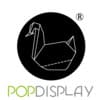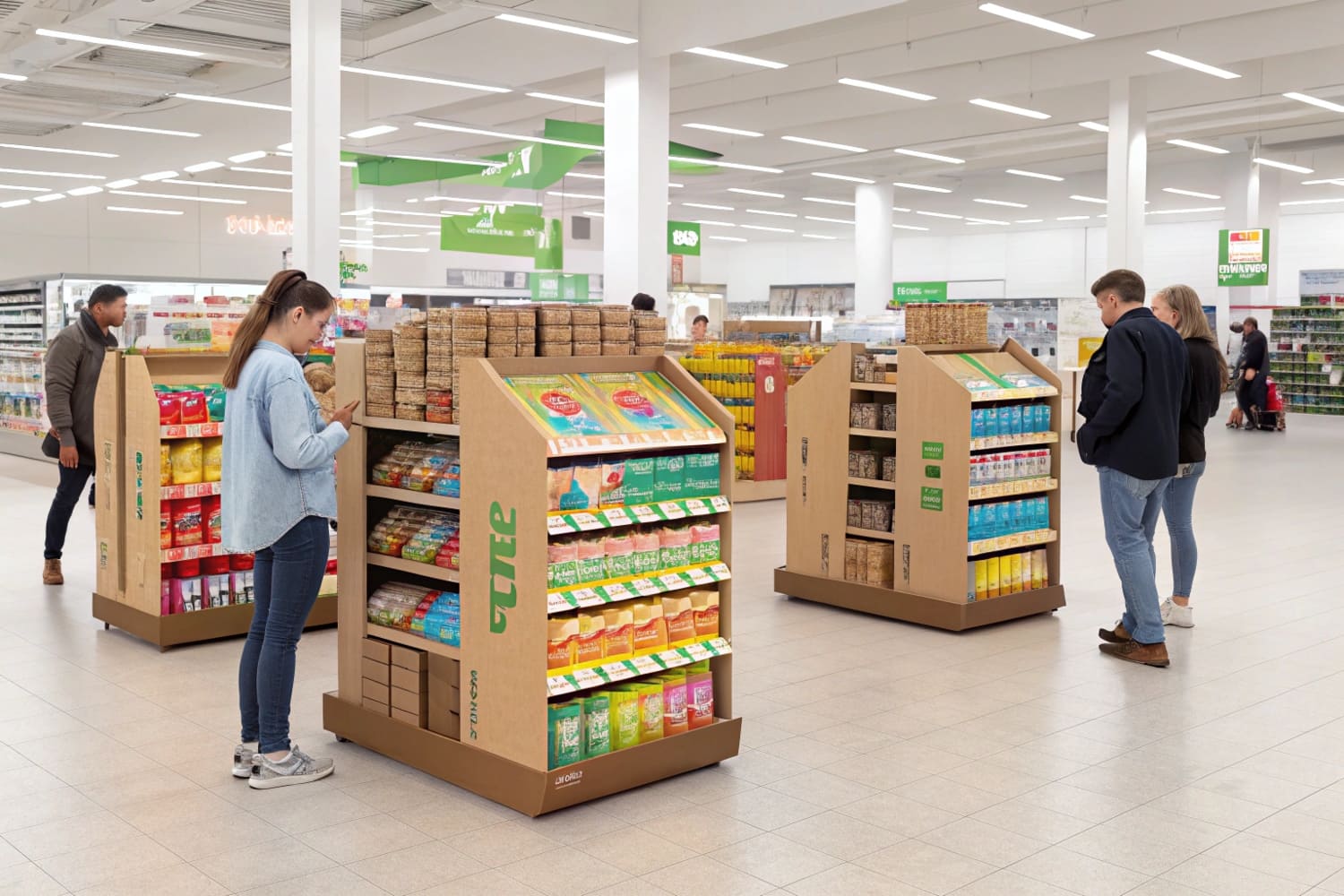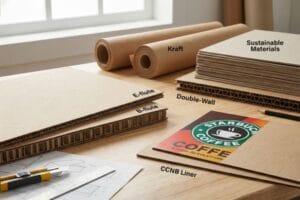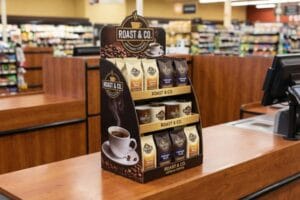Shoppers move fast. My products get seconds to win attention. I need a display that sets up fast, looks sharp, and sells now. PDQ displays fix that problem today.
A PDQ display is a prepacked, quick-to-set-up cardboard unit that ships retail-ready, drops on a pallet or shelf, and starts selling immediately; it boosts visibility, controls facings, and simplifies replenishment.
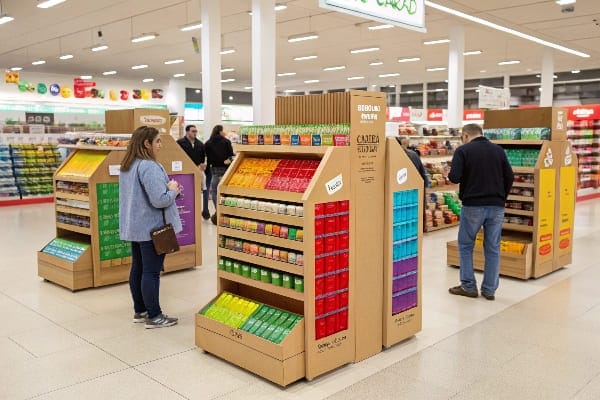
I will keep this simple and useful. I will explain what PDQ means in stores and in design. I will compare PDQ and POP. I will show what PDQ means for business results.
What does PDQ stand for in merchandising?
Staff need clear instructions. They do not have time to build complicated displays. I use PDQ to cut confusion, speed setup, and keep the shelf clean.
In merchandising, PDQ stands for “Pretty Darn Quick” or “Product Displayed Quickly”; it means a prepacked, retail-ready unit that sets up fast, keeps products faced, and drives impulse buys at checkout or high-traffic spots.
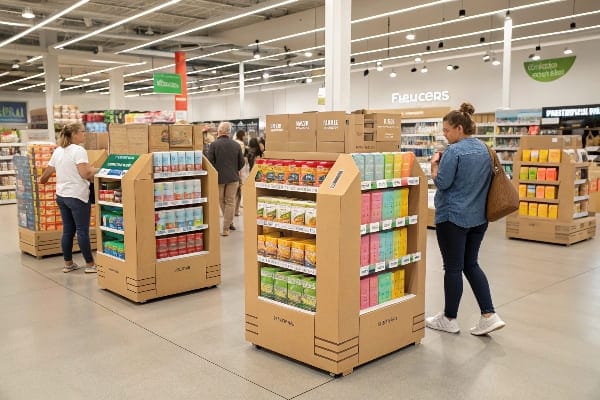
How teams use PDQ1
A PDQ unit arrives packed with product. A worker removes a lid or tear strip. The unit goes onto a shelf, counter, or pallet. This takes minutes. I see fewer errors and faster resets2. I also see cleaner facings during the day. The shape guides the product. The graphics guide the shopper. Store teams like it because it saves labor during peak hours3.
Where PDQ sits
I place PDQ near the checkout, on endcaps4, or on pallets. Countertop PDQ5 works best for small goods. Pallet PDQ6 works for seasonal bundles. Floor PDQ7 sells larger packs. I choose the spot by traffic, not by habit. I test one store first, then scale.
Metrics that matter
I track setup time8, sell-through9, and out-of-stock minutes. I also track damage and returns. PDQ helps on all five. The gains feel small by store, but they add up across chains. When a buyer asks for a clean plan, PDQ earns trust because it is simple.
| Aspect | Why it matters | My note |
|---|---|---|
| Prepacked10 | Cuts labor and errors | Saves minutes per store |
| Facings control11 | Holds planogram | Reduces messy shelves |
| Small footprint | Fits tight spaces | Great for checkout |
| Graphics panel | Signals brand fast | Helps impulse buys |
| Tear-strip lid | Speeds opening | Less knife use and waste |
What does PDQ stand for in design?
Design teams face tight windows. Print, cut, and ship must move in sync. I use PDQ design rules to avoid surprises and keep assembly tool-free.
In design, PDQ keeps the “quick” promise: dielines, board grade, and print all target tool-free, minutes-fast assembly; the flat-pack ships small, pops up clean, and holds product with simple locks.
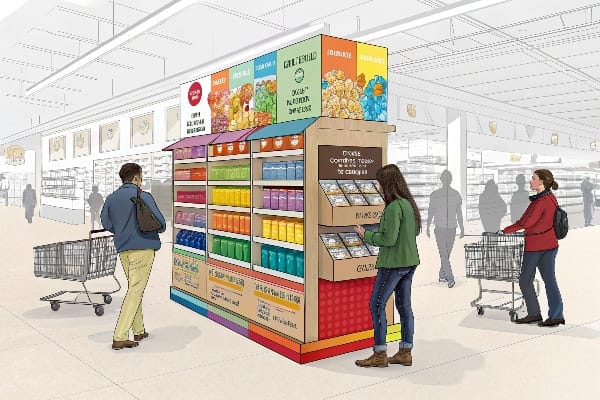
Dielines that work
I start with one-piece or two-piece dielines. I favor auto-lock bases12 and tuck tabs. I avoid tiny tabs that tear. I label fold order clearly. I place stress lines away from view. I design for flat-pack to cut freight.
Materials and print
Most PDQ units use corrugated board. Single-wall E, B, or BE flute balances print quality and strength. I use water-based inks13 for clean color. Digital print helps short runs and fast revisions. This supports seasonal drops and regional tests. Europe buyers ask for more eco claims. I plan FSC and recycled content early.
Fit, form, and test
I test with real product, not placeholders. I check tear strips and perforations. I run transport tests14 and load tests. I watch for humidity risk15. I use simple glues or tapes. I keep assembly under three steps. If a store clerk needs a manual, I redesign.
| Design Element | Good Choice | Risk if wrong | My tip |
|---|---|---|---|
| Board grade | Single-wall B/E flute | Crush or warp | Match to weight and climate |
| Closure | Auto-lock base16 | Weak bottom | Add double tuck for heavy SKUs |
| Graphics | Large brand blocks | Small text | Use high contrast near logo |
| Print method | Digital for short runs | Long changeovers | Use litho-lam for big volumes |
| Sustainability | Recycled content, FSC17 | Mixed layers | Avoid plastic films if possible |
What is the difference between PDQ and pop?
Buyers hear both terms. Some think they are the same. I explain the scope first, then I show how PDQ fits inside POP.
PDQ is a sub-type of POP (Point-of-Purchase) displays; PDQ highlights speed and prepack, while POP covers all retail displays, including floor, pallet, counter, endcap, and interactive units.
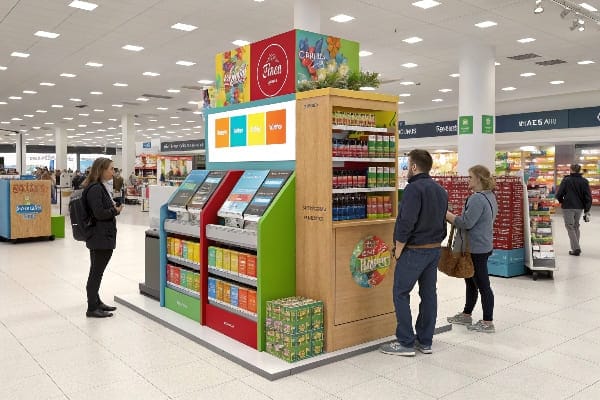
Category vs tool
POP18 is the big category. It includes floor displays19, pallet displays20, shelf trays21, and more. PDQ22 is a tool inside that category. PDQ is about setup speed and retail-ready packs. Many POP items are not prepacked. They need planogramming and hand fill. I choose PDQ when time and labor are tight.
Use cases and impact
Floor POP can carry a large load and create strong presence. In my experience, floor displays2 often take the largest share in unit count across campaigns because they stand alone and shout the brand. PDQ works best when I want fast trials and tight control near checkout. When I supported a U.S. hunting launch, the team needed strict dates. We used PDQ trays for broad chains and one pallet display for club stores. The mix hit both speed and scale.
| Item | PDQ | POP (broader) |
|---|---|---|
| Scope | Prepacked, retail-ready23 | All display types |
| Setup | Minutes, tool-free24 | Varies by design |
| Best location | Checkout, shelves, small spaces | Endcaps, aisles, pallets |
| Volume | Small to medium | Small to very large |
| Labor need | Very low | Low to high |
| Goal | Speed, impulse, trials | Presence, storytelling, stock depth |
What is a PDQ in business?
A display is not art alone. It must pay back. I use PDQ to speed launches, cut labor, and stabilize cost.
In business, PDQ is a sales and operations lever: it speeds time-to-shelf, reduces store labor, protects facings, boosts trial, and gives predictable costs for seasonal and new-product campaigns.
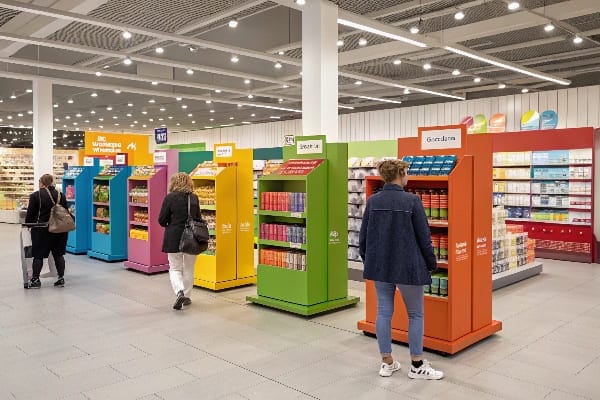
ROI model
I keep the math simple. I measure savings from faster setup and fewer damages25. I track added units from impulse buys. I compare print methods and lot sizes. I test one region, then scale. For many FMCG, the lift plus labor savings offsets design and tooling in the first run.
Operations and timing
Retail windows are short. I build PDQ around flat-pack logistics and quick kitting. My plant runs three lines, so I split work across them to meet dates. I keep digital print in the mix for rush changes. I freeze art early to avoid rework. I send clear assembly steps on the shipper.
Markets and growth
I see strong demand in North America because retail is mature. I see faster growth in Asia Pacific with urbanization and new stores. Europe pushes sustainability the most26. Buyers ask for recycled content, water-based inks, and easy recycling. These trends shape PDQ specs. Brands pick eco-first claims because shoppers care and chains enforce standards.
Risk and control
Trade rules can move costs. Raw material swings can hit board prices. I protect quotes with short validity and clear grade specs. I keep a second board mill ready. I verify certifications. I test transport for long routes. When I worked with a U.S. hunting brand, we had tight launch dates. We locked PDQ dielines first, then artwork. We hit the window because the structure was stable from day one.
| KPI | Target | Why it helps | How PDQ helps |
|---|---|---|---|
| Setup time27 | Under 5 minutes | Less labor cost | Prepacked, tear-strip lid |
| Damage rate | Under 1% | Protect margin | Strong board, fit test |
| Out-of-stock minutes | Fewer each day | Keep sales | Easy refill tray |
| Sell-through lift28 | +5–20% vs shelf | Trial and impulse | Bold graphics near checkout |
| Freight cost per unit | Lower each run | Profit control | Flat-pack, nested parts |
Conclusion
PDQ means quick setup and clear results. It fits the shelf fast, shows the brand, and helps launches. It is simple to design, easy to ship, and ready to sell.
Explore this link to understand how PDQ displays enhance efficiency and improve customer experience in retail settings. ↩
This resource will provide valuable information on improving operational efficiency and customer satisfaction in retail environments. ↩ ↩
Exploring this link will reveal insights on efficiency and cost-saving strategies for retail operations. ↩
Explore this link to discover effective strategies for maximizing sales with endcaps in your store layout. ↩
Understanding Countertop PDQ can enhance your retail strategy by optimizing product placement for small goods. ↩
Exploring Pallet PDQ can provide insights into effective seasonal marketing and larger product displays. ↩
Explore this link to understand how Floor PDQ can optimize product placement and boost sales effectively. ↩
Reducing setup time can significantly boost efficiency and profitability in your retail business. ↩
Understanding sell-through can enhance your sales strategy and improve inventory management. ↩
Exploring this link will reveal how prepacked products can enhance efficiency and reduce errors in retail. ↩
This resource will provide insights into how facings control can optimize shelf organization and enhance customer experience. ↩
Explore this link to understand how auto-lock bases enhance packaging efficiency and stability. ↩
Discover the advantages of water-based inks for eco-friendly printing and vibrant colors. ↩
Explore this link to learn about best practices for transport tests, ensuring your products withstand real-world conditions. ↩
Discover strategies to evaluate humidity risk, which is crucial for maintaining product integrity during transport. ↩
Explore this link to understand how an auto-lock base enhances packaging strength and efficiency. ↩
Learn about the environmental advantages of using recycled content and FSC certification in packaging. ↩
Explore this link to understand the significance of POP in retail, its types, and how it enhances brand visibility. ↩
Discover the significance of floor displays in retail marketing and how they can elevate brand visibility and sales. ↩
Explore this link to discover effective strategies for maximizing the impact of pallet displays in your retail environment. ↩
Explore this link to understand shelf trays’ role in enhancing product visibility and sales in retail environments. ↩
Explore this link to understand how PDQ enhances setup speed and efficiency in retail, crucial for tight timelines. ↩
Discover how prepacked retail-ready displays can enhance your sales strategy and improve customer engagement. ↩
Learn about the efficiency and convenience of tool-free setups for retail displays, saving time and labor costs. ↩
Understanding these benefits can help optimize your retail strategy and improve overall efficiency. ↩
Exploring this topic reveals key trends that can enhance your brand’s eco-friendly initiatives and market appeal. ↩
Explore this link to discover innovative methods that can streamline your setup process and reduce costs. ↩
This resource provides insights on boosting sales through effective merchandising and marketing strategies. ↩
